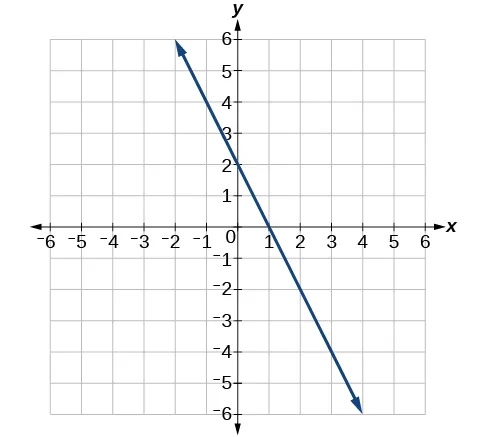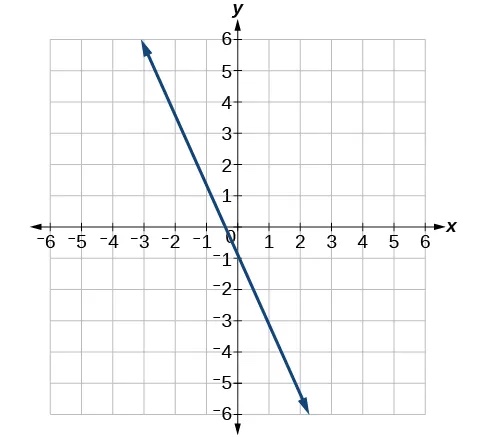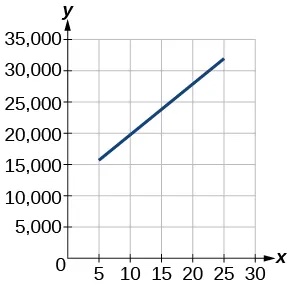Chapter 4 Linear Functions
Chapter 4 Practice Test
Chapter Practice Test
For the following exercises, find the equation of the line with the given information..
- Passes through the points[latex]\,\left(-4,2\right)\,[/latex]and[latex]\,\left(5,-3\right).[/latex]
Show Solution
[latex]y=\frac{-5}{9}x-\frac{2}{9}[/latex]
- Has an undefined slope and passes through the point[latex]\,\left(4,3\right).[/latex]
- Passes through the point[latex]\,\left(2,1\right)\,[/latex]and is perpendicular to[latex]\,y=\frac{-2}{5}x+3.[/latex]
Show Solution
[latex]y=\frac{5}{2}x-4[/latex]
- Determine whether the following algebraic equation can be written as a linear function.[latex]\,2x+3y=7[/latex]
- Determine whether the following function is increasing or decreasing.[latex]\,f\left(x\right)=-2x+5[/latex]
Show Solution
Decreasing
- Determine whether the following function is increasing or decreasing.[latex]f\left(x\right)=7x+9[/latex]
- Find a linear equation that passes through (5, 1) and (3, –9), if possible.
Show Solution
[latex]y=5x-24[/latex]
- Find a linear equation that has an x intercept at (–4, 0) and a y-intercept at (0, –6), if possible.
- Find the slope of the line in Figure 1.

Show Solution
[latex]m=-2[/latex]
- Write an equation for line in Figure 2.

- Does the table below represent a linear function? If so, find a linear equation that models the data.
| [latex]x[/latex] | –6 | 0 | 2 | 4 |
| [latex]g\left(x\right)[/latex] | 14 | 32 | 38 | 44 |
Show Solution
Yes,[latex]\,y=3x+32[/latex]
- Does the table below represent a linear function? If so, find a linear equation that models the data.
| x | 1 | 3 | 7 | 11 |
| g(x) | 4 | 9 | 19 | 12 |
- At 6 am, an online company has sold 120 items that day. If the company sells an average of 30 items per hour for the remainder of the day, write an expression to represent the number of items that were sold[latex]\,n\,[/latex]after 6 am.
Show Solution
[latex]y=30x+120[/latex]
For the following exercises, determine whether the lines given by the equations below are parallel, perpendicular, or neither parallel nor perpendicular.
- [latex]\begin{array}{c}y=\frac{3}{4}x-9\\ -4x-3y=8\end{array}[/latex]
- [latex]\begin{array}{c}-2x+y=3\\ 3x+\frac{3}{2}y=5\end{array}[/latex]
Show Solution
Neither
- Find the x– and y-intercepts of the equation[latex]\,2x+7y=-14.[/latex]
- Given below are descriptions of two lines. Find the slopes of Line 1 and Line 2. Is the pair of lines parallel, perpendicular, or neither?
Line 1: Passes through[latex]\,\left(-2,-6\right)\,[/latex]and[latex]\,\left(3,14\right)[/latex]
Line 2: Passes through[latex]\,\left(2,6\right)\,[/latex]and[latex]\,\left(4,14\right)[/latex]
Show Solution
Line 1:[latex]\,m=4;[/latex] Line 2:[latex]\,m=4;[/latex]parallel
- Write an equation for a line perpendicular to[latex]\,f\left(x\right)=4x+3\,[/latex]and passing through the point[latex]\,\left(8,10\right).[/latex]
- Sketch a line with a y-intercept of[latex]\,\left(0,\text{5}\right)\,[/latex]and slope[latex]\,-\frac{5}{2}.[/latex]
- Graph of the linear function[latex]\,f\left(x\right)=-x+6.[/latex]
- For the two linear functions, find the point of intersection:[latex]\begin{array}{c}x=y+2\\ 2x-3y=-1\end{array}.[/latex]
Show Solution
[latex]\left(7,5\right)[/latex]
- A car rental company offers two plans for renting a car.
Plan A: $25 per day and $0.10 per mile
Plan B: $40 per day with free unlimited mileage
How many miles would you need to drive for plan B to save you money?
- Find the area of a triangle bounded by the y axis, the line[latex]\,f\left(x\right)=12-4x,[/latex]and the line perpendicular to[latex]\,f\,[/latex]that passes through the origin.
Show Solution
16.94 square units
- A town’s population increases at a constant rate. In 2010 the population was 65,000. By 2012 the population had increased to 90,000. Assuming this trend continues, predict the population in 2018.
- The number of people afflicted with the common cold in the winter months dropped steadily by 25 each year since 2002 until 2012. In 2002, 8,040 people were afflicted. Find the linear function that models the number of people afflicted with the common cold[latex]\,C\,[/latex]as a function of the year,[latex]\,t.\,[/latex]When will less than 6,000 people be afflicted?
Show Solution
2083
For the following exercises, use the graph in Figure 3, showing the profit, [latex]y,[/latex] in thousands of dollars, of a company in a given year,[latex]\,x,[/latex] where[latex]\,x\,[/latex]represents years since 1980.

- Find the linear function[latex]\,y,[/latex] where[latex]\,y\,[/latex]depends on[latex]\,x,[/latex] the number of years since 1980.
- Find and interpret the y-intercept.
Show Solution
[latex]\left(0,10,625\right);[/latex]In 1980, the profit was $10,625,000.
- In 2004, a school population was 1250. By 2012 the population had dropped to 875. Assume the population is changing linearly.
- How much did the population drop between the years 2004 and 2012?
- What is the average population decline per year?
- Find an equation for the population, P, of the school t years after 2004.
- Is the following ordered pair a solution to the system of equations?
[latex]\begin{array}{l}\\ \begin{array}{l}-5x-y=12\,\hfill \\ x+4y=9\hfill \end{array}\end{array}[/latex]with[latex]\,\left(-3,3\right)[/latex]
Show Solution
Yes
For the following exercises, solve the systems of linear and nonlinear equations using substitution or elimination. Indicate if no solution exists.
- [latex]\begin{array}{r}\frac{1}{2}x-\frac{1}{3}y=4\\ \frac{3}{2}x-y=0\end{array}[/latex]
- [latex]\begin{array}{r}\hfill \begin{array}{l}\\ -\frac{1}{2}x-4y=4\end{array}\\ \hfill 2x+16y=2\end{array}[/latex]
Show Solution
No solutions exist.
Media Attributions
- Ch 4 Practice Test Figure 1 © OpenStax Algebra and Trigonometry is licensed under a CC BY (Attribution) license
- Ch 4 Practice Test Figure 2 © OpenStax Algebra and Trigonometry is licensed under a CC BY (Attribution) license
- Ch 4 Practice Test Figure 3 © OpenStax Algebra and Trignometry is licensed under a CC BY (Attribution) license

